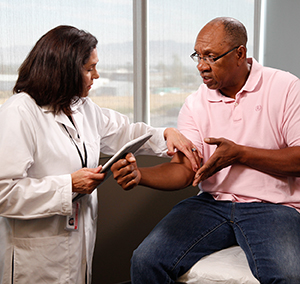Cortisone is a type of steroid. It can greatly reduce swelling, redness, inflammation, and pain. Being injected with cortisone is simple and doesn’t take long. Your healthcare provider may ask you questions about your health. Cortisone can affect certain health conditions, such as diabetes.
Why have a cortisone injection?
Injecting cortisone can sometimes relieve pain for anything from a sports injury to arthritis. Your healthcare provider may suggest an injection if rest, splints, physical therapy, rehabilitation exercises, or oral medicine doesn’t relieve your pain. Injecting cortisone is simpler than having surgery. And cortisone may provide the lasting pain relief that can help you get out and enjoy life again. Be sure to discuss all choices with your healthcare provider. Injections are usually used no more than 3 to 4 times a year in 1 area of the body.
Getting the injection
Your healthcare provider will start by cleaning and possibly numbing your skin at the injection site. Next you’ll be injected with local anesthetics (for short-term pain relief) and cortisone. The injection may last a few moments. A small bandage will be put over the injection site. You’ll then be ready to go home.
After your injection
After being injected, make sure you don’t injure the treated region. But stay active. Enjoy a walk or some other mild activity. Just be careful not to strain the region that gave you trouble.
The next day
Some people feel more pain after being injected. This is normal, and it will go away soon. Applying ice for
Cortisone injections and diabetes
Cortisone injections can increase your blood sugar for several days after the injection. If you have diabetes, watch your blood sugar closely during this time. Follow your regular plan for what to do when your blood sugar is elevated.


